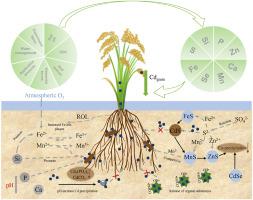Chemosphere ( IF 8.1 ) Pub Date : 2023-09-25 , DOI: 10.1016/j.chemosphere.2023.140282
Pengwei Zhao 1 , Peicheng Huang 1 , Xiao Yan 1 , Arinzechi Chukwuma 1 , Sen Yang 1 , Zhihui Yang 2 , Huan Li 3 , Weichun Yang 2

|
安全修复镉污染农田的一个有前途的策略是应用矿质元素,它可以减少水稻中镉的积累并抑制其在镉污染农田中的生物利用度。然而,对于不同矿质元素如何影响水稻镉积累和土壤镉生物有效性,目前仍缺乏系统、定量的评价。在此,基于 137 篇已发表著作中的 1062 个个体观察结果进行了荟萃分析,探讨了 Si、P、Zn、Ca、Mn、Se、Fe 和 S 对水稻 Cd 积累和土壤 Cd 生物有效性的影响,我们的目的是确定控制稻米Cd浓度降低的关键因素 结果表明,外源元素的存在显着降低了水稻籽粒中Cd浓度,其降序为:Fe(43.03%)>P(38.45%)>Si(33.24%)>Ca(31.90%)>Se(29.83%)。 ) > Zn (25.95%) > Mn (23.26%) > S (18.78%)。Ca、P和Si元素显着降低了土壤中Cd的生物有效性,分别降低了29.87%、27.80%和22.70%。这些元素对镉生物有效性的影响似乎受到土壤理化性质的控制,例如 pH 值、土壤有机碳 (SOC) 以及水管理、施用量和元素形态。总体而言,本研究为利用外源矿质元素减轻水稻和农田镉污染的潜力提供了有价值的见解,并促进矿质元素的选择和应用,以安全利用受镉污染农田,同时考虑土壤性质和其他因素。影响其效果的因素。
,安全修复镉污染农田的一个有前途的策略是应用矿质元素,它可以减少水稻中镉的积累并抑制其在镉污染农田中的生物利用度。然而,对于不同矿质元素如何影响水稻镉积累和土壤镉生物有效性,目前仍缺乏系统、定量的评价。在此,基于 137 篇已发表著作中的 1062 个个体观察结果进行了荟萃分析,探讨了 Si、P、Zn、Ca、Mn、Se、Fe 和 S 对水稻 Cd 积累和土壤 Cd 生物有效性的影响,我们的目的是确定控制稻米Cd浓度降低的关键因素 结果表明,外源元素的存在显着降低了水稻籽粒中Cd浓度,其降序为:Fe(43.03%)>P(38.45%)>Si(33.24%)>Ca(31.90%)>Se(29.83%)。 ) > Zn (25.95%) > Mn (23.26%) > S (18.78%)。Ca、P和Si元素显着降低了土壤中Cd的生物有效性,分别降低了29.87%、27.80%和22.70%。这些元素对镉生物有效性的影响似乎受到土壤理化性质的控制,例如 pH 值、土壤有机碳 (SOC) 以及水管理、施用量和元素形态。总体而言,本研究为利用外源矿质元素减轻水稻和农田镉污染的潜力提供了有价值的见解,并促进矿质元素的选择和应用,以安全利用受镉污染农田,同时考虑土壤性质和其他因素。影响其效果的因素。

"点击查看英文标题和摘要"































 京公网安备 11010802027423号
京公网安备 11010802027423号